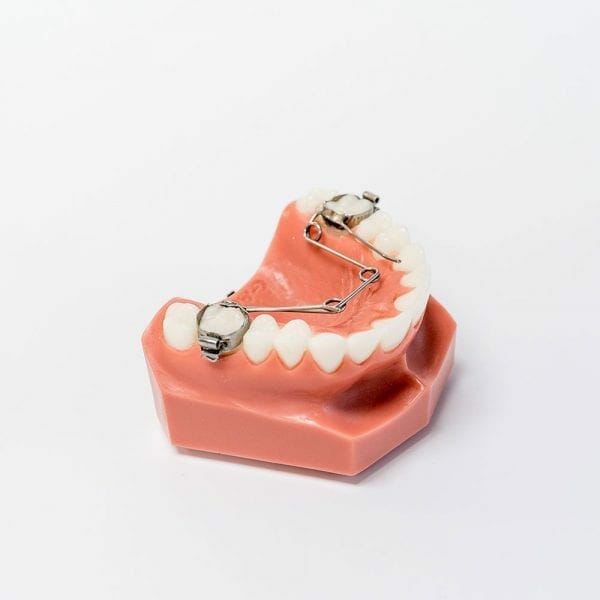When A Habit Appliance Can Help
Many families don’t think of the orthodontist’s office as a place to seek help for thumb sucking. However, an orthodontic device called a habit appliance is extremely effective at breaking the thumb sucking habit. Learn more about how to stop the thumb sucking habit with this simple appliance for your child.
At Burke & Redford Orthodontists, Dr. Redford and Dr. Burke believe in educating patients and their families about the different ways we can help improve smiles and correct bites. We will examine the damaging effects of chronic thumb sucking, remedies to try at home, and how a habit appliance can help.
When Thumb Sucking Becomes A Problem
 Sucking and rooting are two natural reflexes of babies—helping them to drink from the breast or bottle. Many babies also suck on their fingers or thumb as a way to soothe themselves. As children get older, the habit usually stops on its own as children find other ways to calm themselves.
Sucking and rooting are two natural reflexes of babies—helping them to drink from the breast or bottle. Many babies also suck on their fingers or thumb as a way to soothe themselves. As children get older, the habit usually stops on its own as children find other ways to calm themselves.
Some children stop sucking their thumb as early as 6 months old, while others begin tapering off by the age of 2. The majority of children stop sucking their thumb by the age of 4. However, some children persist with this detrimental habit for years.
According to the American Academy of Pediatrics, intervention into a child’s thumb sucking habit is only needed when the habit persists beyond the child’s 5th birthday.
Effects of Thumb Sucking
Thumb sucking becomes problematic after the age of 5 because of the long-term problems it creates with a child’s teeth, bite, and jaw. If thumb sucking persists, a child might have problems with speech and chewing. Another possibility is the development of an open bite (when the upper and lower teeth don’t touch when the mouth is closed).
The longer children suck on their thumb, the more damage they can do. Regular thumb sucking can push out the upper front teeth and tip in the lower front teeth. As the teeth move, the jaw reforms around the teeth’s new positions. This happens because the jaws of young children are soft and flexible. As a result, a hole or gap starts to form at the front of the mouth. This is called an open bite.
Talking To Children About Thumb Sucking
If a child is still sucking their thumb past the age of 5, intervention is needed. Sometimes, parents find that social pressure will do the job. Once children enter kindergarten, they may find peers noticing and commenting on their thumb sucking habit. This is often enough to get a child to stop.
However, social pressure might not work on every child. In fact, what works for one child will not necessarily work for another. Therefore, it is critical to try a few different approaches until the right solution is found.
Before beginning any home remedy, it is best to talk with children about why they need to stop sucking their thumb. Discuss how thumb sucking spreads germs, moves teeth out of alignment, and may impair speech. Find out why they do it (triggers) and what they think might help them stop. Having this discussion helps children understand why stopping the habit is important, involves them in the process, and increases the chances of success.
Home Remedies for Thumb Sucking
Below are some home remedies for stopping the thumb sucking habit. The goal is to stop the pattern for at least 2 weeks. After 2 weeks, most children will cease the habit entirely.
- Positive Reinforcement. Set small goals. Provide praise and small rewards when the goals are met. Keep expanding the goals until the habit is gone. Keep track of days with no thumb sucking by putting a sticker or star on a calendar.
- Replace The Habit. If a child uses thumb sucking for stress relief, try to find other methods to relieve stress—such as a stuffed animal to squeeze or a pillow to hug. Another option is chewlery (chewable jewelry), which is made specifically for children who need to chew or suck.
- Whenever the child sucks their thumb, a gentle reminder should be given. Sometimes children suck their thumb without realizing it.
- Books and Videos. Look for books, TV shows, or YouTube videos that discuss thumb sucking and read/watch them together. Hearing the message from someone other than a parent is often helpful. A visit to the family dentist might also be useful.
- Bad-Tasting Nail Polish. A common solution is painting a child’s nails with bad-tasting nail polish. The taste acts as a deterrent and helps stop the habit.
- Thumb or Finger Covers. Several brands of plastic or cloth thumb covers are available to prevent kids from sucking their thumbs.
- Prevent the Elbow from Bending. One option is to wrap the elbow in an ace bandage—making it difficult for a child to bend the elbow to the put the thumb in the mouth. Another option is a device called the Nipit Hand Stopper.
If these methods don’t work, it might be time to talk to an orthodontist about a habit appliance.
Habit Breaker Appliance

The habit breaker appliance is a fixed appliance that blocks children from putting their thumb in their mouths. It also helps break the “seal” that children find comfortable when closing their lips over a finger that is in their mouth. It is successful 90% of the time. The device typically stays in place for several months to completely break the habit. This is also a great appliance to stop lip biting.
The appliance consists of stainless steel rings (bands) attached to the back molars. Metal springs and wires prevent the thumb from being sucked—thereby removing the soothing or pleasurable aspects of the habit.
As a result of being unable to suck their thumb, children may be crabby or have trouble sleeping for a few weeks. This is to be expected as they are losing their method of self-soothing. However, over time, they will find other ways to relieve stress and anxiety that don’t involve damaging their teeth.
If a child is significantly older (tween or teen) when trying to break the thumb sucking habit, it might be helpful to obtain counseling from a therapist. This will help to ease the transition and teach the child coping skills.
Treatment to stop these habits means your child won’t need adult braces as they get older, and it will save you money in the long run.
If you have questions or concerns about the habit appliance and its use on how to stop the thumb sucking habit, contact Burke & Redford Orthodontists at (951) 699-8011 or fill out the contact form on our website. Schedule a free consultation that works with your schedule.